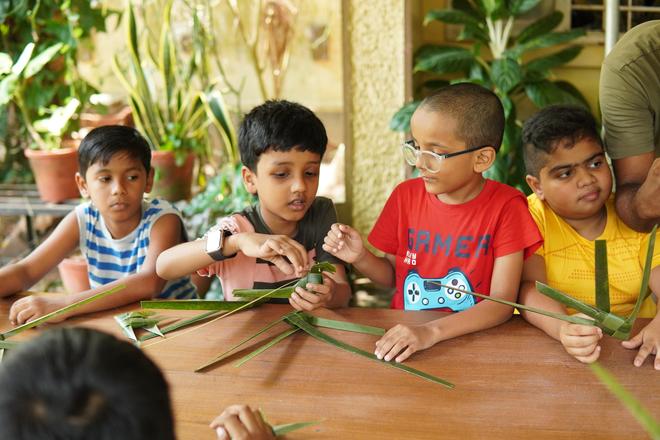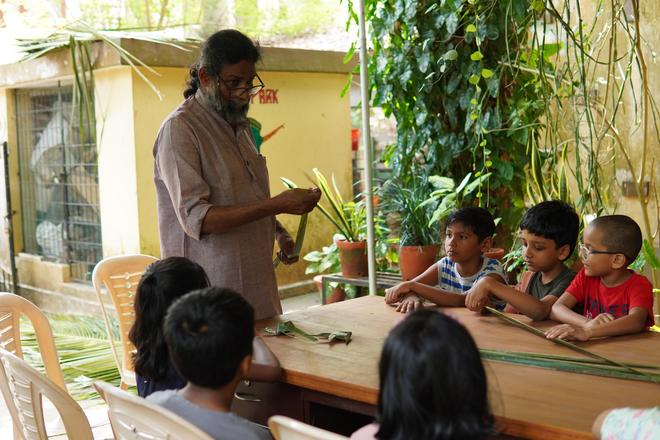Fronds of coconut palm leaves come alive at John Baby’s nimble fingers. With a twist here, a snip there and a piece of coconut rib to hold the fronds in place, the leaves turn into birds, fish, snakes, trumpets, balls and caps.
At Thalir, a workshop conducted by NGO Thanal in Thiruvananthapuram, children between the ages of seven and 14 follow the pony-tailed master palm leaf artist and sculptor Baby’s instructions carefully as he shows them how to braid and fold the palm leaves and its rib to make toys and other objects.
Disregarding the heat, the children enthusiastically showcase the fish, birds, spectacles, crowns and balls made by them. Seven-year-old Ardra AR proudly shows her green bird while seven-year-old Aydin Mohammed displays a fish swaying at the end of a makeshift line. C Jayakumar, executive director of Thanal, goes around blowing a trumpet that John made for him even as he attempts to make one of his own.
John says he feels fulfilled if he has awakened the interest of even five of the children to explore their surroundings and not depend on mass produced toys for entertainment.

Growing up at Haripad in Alappuzha district, it was natural for John to play with what was available in the surroundings. “I was quite a handful and to keep me occupied, agricultural labourers working in our paddy fields used to show me how to craft these articles,” recalls John. Little did he imagine that the medium would make him a keeper of a vanishing art form.
Once he became a father, John made the same handmade toys for his son, Minon, and daughter, Minto. On his son’s insistence, John came up with more ingenious toys made of palm leaves.
“Coconut palms are part of our lifestyle in Kerala. Roofs used to be thatched palm leaves and woven palm leaves were used for houses, celebrations, and worship. With the advent of concrete houses and flats, we have cut ourselves away from our roots,” says John.

To learn indigenous methods of using golden yellow tender coconut fronds for decoration, Baby spent time with artists practising art forms such as Thullal, Theyyam and Padayani. “They weave the kuruthola (tender coconut leaves) in myriad patterns. That art is fading away before our eyes. Recently, I was deeply saddened to watch a Seethankan Thullal artiste adorn himself with plastic ornaments in place of the kuruthola,” says John.
Even when children moved on from homemade toys to gizmos and screens, John did not stop using his skills to create articles from coconut palm leaves. At present, the septuagenarian is busy sharing his creativity with youngsters to keep the tradition and knowledge alive.
Recently, under a scheme of the Lalitakala Akademi, he taught 20 artisans to make handmade articles from screwpine leaves. He used to take classes in crafting at Kerala State Institute of Design.
“The disadvantage of coconut palm leaves is that they dry quickly and can’t be preserved for long. But screwpine leaves last. That is why I have started making with screwpine leaves,” he explains.
Displaying a delicate dragonfly and artfully made figures of animals, insects and boxes, John hopes the government recognises the value of such articles as souvenirs instead of promoting expensive handicraft mementos found in tourist centres.
John feels that by ignoring such indigenous crafts and skills, children lose out on picking up valuable finger dexterity that will be of help to them in their academics as well.

“It improves concentration, imagination and eye-hand coordination and instils patience in children,” he says.
Even while talking and interacting with the children, John’s fingers are busy, twining, weaving and knotting the fronds of palm leaf. Finally, with a flourish, he hands me a green cap that he had woven during our conversation! Wearing the hat to shield me against the harsh noon sun, I leave the children engrossed in making the articles John was teaching them.







